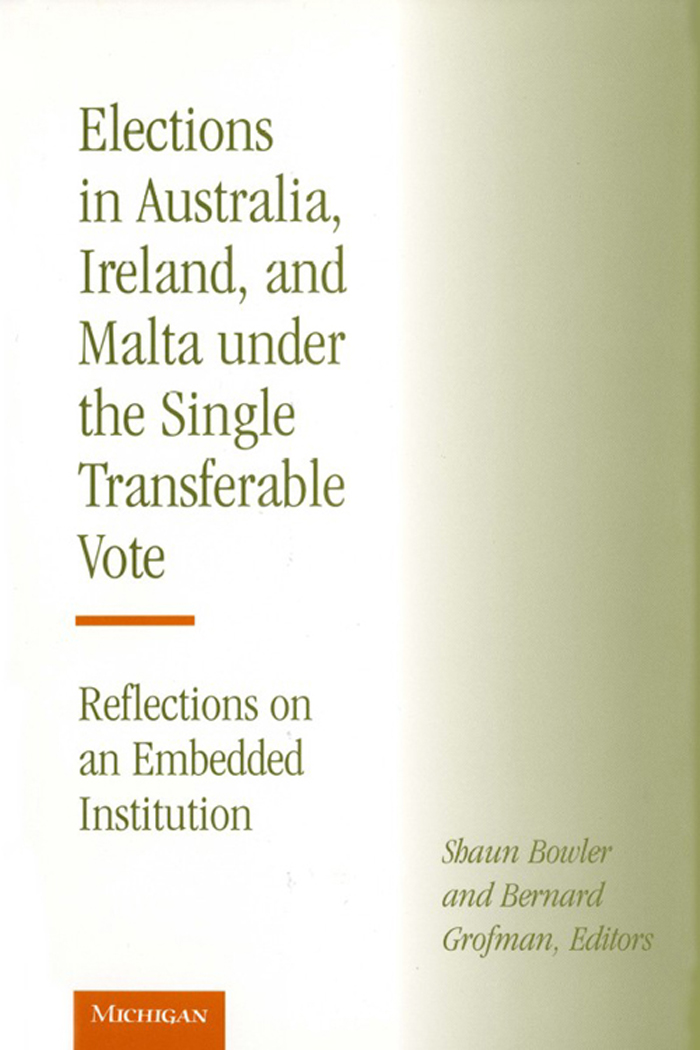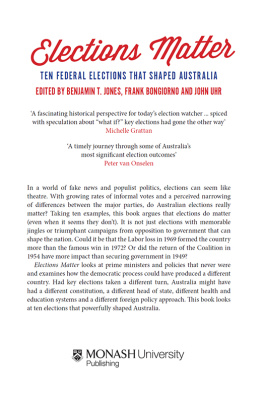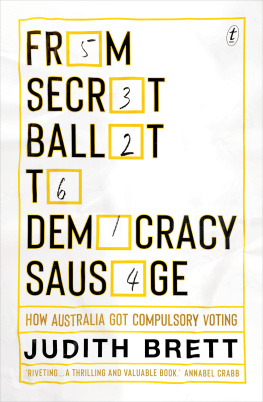Shaun Bowler and Bernard Grofman - Elections in Australia, Ireland, and Malta under the Single Transferable Vote
Here you can read online Shaun Bowler and Bernard Grofman - Elections in Australia, Ireland, and Malta under the Single Transferable Vote full text of the book (entire story) in english for free. Download pdf and epub, get meaning, cover and reviews about this ebook. publisher: The University of Michigan Press, genre: Politics. Description of the work, (preface) as well as reviews are available. Best literature library LitArk.com created for fans of good reading and offers a wide selection of genres:
Romance novel
Science fiction
Adventure
Detective
Science
History
Home and family
Prose
Art
Politics
Computer
Non-fiction
Religion
Business
Children
Humor
Choose a favorite category and find really read worthwhile books. Enjoy immersion in the world of imagination, feel the emotions of the characters or learn something new for yourself, make an fascinating discovery.

- Book:Elections in Australia, Ireland, and Malta under the Single Transferable Vote
- Author:
- Publisher:The University of Michigan Press
- Genre:
- Rating:4 / 5
- Favourites:Add to favourites
- Your mark:
- 80
- 1
- 2
- 3
- 4
- 5
Elections in Australia, Ireland, and Malta under the Single Transferable Vote: summary, description and annotation
We offer to read an annotation, description, summary or preface (depends on what the author of the book "Elections in Australia, Ireland, and Malta under the Single Transferable Vote" wrote himself). If you haven't found the necessary information about the book — write in the comments, we will try to find it.
Elections in Australia, Ireland, and Malta under the Single Transferable Vote — read online for free the complete book (whole text) full work
Below is the text of the book, divided by pages. System saving the place of the last page read, allows you to conveniently read the book "Elections in Australia, Ireland, and Malta under the Single Transferable Vote" online for free, without having to search again every time where you left off. Put a bookmark, and you can go to the page where you finished reading at any time.
Font size:
Interval:
Bookmark:

Elections in Australia, Ireland, and Malta under the Single Transferable Vote
Reflections on an Embedded Institution
Edited by Shaun Bowler and Bernard Grofman
Ann Arbor
T HE U NIVERSITY OF M ICHIGAN P RESS
Copyright by the University of Michigan 2000
All rights reserved
Published in the United States of America by
The University of Michigan Press
Manufactured in the United States of America
 Printed on acid-free paper
Printed on acid-free paper
2003 2002 2001 2000 4 3 2 1
No part of this publication may be reproduced, stored in a retrieval system, or transmitted in any form or by any means, electronic, mechanical, or otherwise, without the written permission of the publisher.
A CIP catalog record for this book is available from the British Library.
Library of Congress Cataloging-in-Publication Data
Elections in Australia, Ireland, and Malta under the single transferable vote :
reflections on an embedded institution / edited by Shaun Bowler and Bernard Grofman.
p. cm.
Includes bibliographical references and index.
ISBN 0-472-11159-0 (cloth : alk. paper)
1. Single transferable votingCase studies. 2. Single transferable votingAustralia. 3. Single transferable votingIreland. 4. Single transferable votingMalta. 5. Single transferable votingCanada. 6. Preferential ballot. I. Bowler, Shaun, 1958. II. Grofman, Bernard.
JF1071 .B69 2000 | |
324.6'5dc21 | 00-031640 |
ISBN13 978-0-472-11159-6 (cloth)
ISBN13 978-0-472-02681-4 (electronic)
Shaun Bowler and Bernard Grofman
David M. Farrell and Ian McAllister
Ben Reilly and Michael Maley
Neal G. Jesse
Michael Gallagher
Michael Marsh
Michael Laver
Colin A. Hughes
Wolfgang Hirczy de Mio and John C. Lane
J. Paul Johnston and Miriam Koene
Nicolaus Tideman and Daniel Richardson
Shaun Bowler and Bernard Grofman
The editors would like to acknowledge the generous financial and intellectual support of the Center for the Study of Democracy, University of CaliforniaIrvine, for this project and also for allied projects on the single nontransferable vote, mixed-member proportional, and list proportional representation. Additional financial support was provided by the University of CaliforniaRiverside. Professor Grofman would also like to note the support of NSF Grant #SBR 9730578 (Program in Methodology, Measurement and Statistics). An earlier and shorter version of the conclusion appeared as Bernard Grofman and Shaun Bowler, STV in the Family of Electoral Systems, Representation 34, no. 1 (winter 1997): 4347. The editors would also like to thank the reviewers of this volume for their careful reading and many constructive suggestions.
The single transferable vote system (STV) is an important electoral system for both practical and theoretical reasons. In allowing voters to identify a rank ordering of their preferences and not just to mark an X, STV permits voters greater choice and makes possible ballot splitting to express highly differentiated preferences. In particular, it allows for the possibility of party-based voting without limiting the voters choices to the candidates of a single party in the way that pure list proportional representation (PR) systems do. Also, in societies that are divided along ethnic or religious lines, STV permits voters to signal strong preferences for candidates of one group while still showing some support for candidates of other groups. For these and other reasons, it has long been advocated by many, beginning with John Stuart Mill, as a tool for electoral reform. But although we regard STV as a very important system in its own right, in this volume we are not merely interested in the study of STV per se; rather, we use STV, and electoral rules more generally, as a lens through which to understand the effects of institutions as being mediated by the political and social context in which they are embedded (Farrell 1997).
What makes STV a particularly useful institution to study for the purposes of this volume is that the three countries we have chosen to look at (Ireland, Australia, and Malta) provide for a kind of natural experiment on the impact of STV in terms of a most similar systems design (Grofman 1999). First, essentially the same electoral system (STV) has been employed in all three societies. Second, all three societies have had sustained historical associations with Great Britain and adapted a number of their political ideas from that source. It might thus appear reasonable to expect that the same electoral arrangement will have broadly similar consequences in these three settings. Yet despite the similarities among these countries, ways in which they differ prove critical to understanding the impact of STV as an embedded institution. The collection of papers contained here shows that the same electoral system can, in fact, have quite different effects under different conditions: STV in Australia is not the same as STV in Ireland, which, in turn, is not the same as STV in Maltaor, indeed, in Canada.
At first glance, this statement may seem relatively trivial. Yet it is trivial neither in its implications nor in the nature of the evidence required for its substantiation. In thinking about political institutions in general and electoral systems in particular, it is often argued that certain basic effects hold across a wide variety of settings (e.g., Duvergers law and hypothesis with respect to the consequences of electoral system types for minimal/maximal levels of party proliferation). We shall argue the case that even what are thought of as basic electoral systems effects can, to a significant extent, be conditional or contingent on other factors.
But laying out that argument is far from all that this volume seeks to accomplish. First, we wish to substantiate in very specific detail the ways in which a given electoral institution, STV, operates differently in different settings. This collection of papers embodies a research design that allows us to demonstrate that the effects of electoral systems vary in meaningful ways. In choosing the disparate settings of Australia, Ireland, and Malta (and also looking at local elections under STV in Canada), we are able to compare what would, on its face, appear to be the same electoral institution across several different national settings. The resulting collection of findings tells us things that neither single-country studies nor solely analytical treatments of electoral systems can tell us and allows us to understand institutions, especially electoral institutions, as embedded within a context of actors and organizations that can shape, and even undermine, our theoretically grounded expectations about the role of institutions. Because we do focus on particular countries, we can take advantage of the knowledge to be gained from detailed case studies by observers with immense country-specific knowledge. This allows us to begin to accomplish our second task: identifying the particular institutional arrangements and/or other factors that interact with STV to modify or curtail its expected effects on party systems and on governance. Here, we shall be paying particular attention to party nomination procedures, on the one hand, and what would appear to be obscure and irrelevant technical details of implementing STV that differ across the three settings, on the other. Of particular importance to the latter group are those laws that regulate the ways in which voters can complete the ballot in expressing preference orders.
Font size:
Interval:
Bookmark:
Similar books «Elections in Australia, Ireland, and Malta under the Single Transferable Vote»
Look at similar books to Elections in Australia, Ireland, and Malta under the Single Transferable Vote. We have selected literature similar in name and meaning in the hope of providing readers with more options to find new, interesting, not yet read works.
Discussion, reviews of the book Elections in Australia, Ireland, and Malta under the Single Transferable Vote and just readers' own opinions. Leave your comments, write what you think about the work, its meaning or the main characters. Specify what exactly you liked and what you didn't like, and why you think so.










